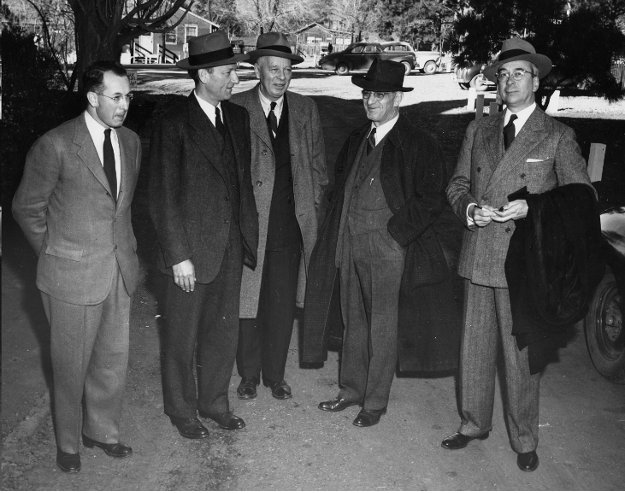Does the White Male Need a Movement?

Fearing repercussions from public assembly, through fringe forums and crudely constructed websites, white male nationalists organized the first of a series of “White Man Marches” on March 15 of this year in major cities across the country. Called “of course” a success by organizer Kyle Hunt, a handful of white men picketed and attracted major news sources, largely for satiric fodder. Overall, the public reaction was belittling.
Historically, white men tend to be far wealthier than any other race and class combination. In addition, they make up the majority of the Obama Administration, the House, Senate, 96 percent of all Fortune 500 CEOs, and continue to get more exposure in TV news, commentary and entertainment. They have made up 43½ of 44 of the last presidents of the free world, and this list could easily go on.
It’s hard to accept the concept of a white group, White Man March participant Matt Parrott says, because most social groups are formed out of injustice.
“[A white group] seems as absurd to you as a ‘Non-Paraplegic Society,’ or an advocacy group for people who don't have cancer,” Parrott says. Parrott used (erroneous) racial slurs, sentences riddled with “you people,” and one rant ending with accusations of having “decadent, godless self-interested lives” at no one person or peoples that was evident, in his emails.
But the status of the white male of European descent in the United States is drastically changing.
To break it down, Pew and other research institutions predict that by 2040, the white race will be a minority; currently, men of the white race make up only 31 percent of the population. White men are the only combination of race and gender that are decreasing in number of college degrees. They are more likely to use depressant drugs such as pain relievers, sedatives, tranquilizers and heroin than any other combination of race and gender. When will the white men’s movement not be seen as a joke?
Richard Spencer, the Executive Director of the National Policy Institute, a white nationalist think tank, says there is a need for the ability to congregate as a racial community. Spencer, who did not know of the White Man march and said it was “a fairly bad idea, poorly executed,” speaks calmly and with an easy laugh about these obviously extremely sensitive issues. He's opposite from Parrott; he’s easy to like.

“Identity is real and it’s really important,” Spencer states. “It may be the most important thing in the world.”
He says that taking away identity is stripping them of family, of what they take for granted, of what they love and what resonates with them.
“Whites in the United States certainly do have an identity, but it’s one that we dare not speak its name--there are certain things we know, like the collective white attitude, ideals and feelings.”
Speaking anecdotally, he said he feels like the prevalence of depressants and what he sees is a cycle of video games and pornography in the white male community could be evidentiary of the white man’s emotional status as aloof, with no need to breadwin, no race to procreate, no exceptional grandiosity about their accomplishments, as “dropping out of life.” He says you could say they’re immature, “or you could say that it’s a coping mechanism for a world that really doesn’t reward them.”
Vanderbilt Law Professor Carol Swain says that if whites become a minority that it should be expected that white people will act like other minority groups, and that it’s futile to argue that other groups have an interest and that whites do not: “There’s no way that you can argue that blacks have an interest, Hispanics have an interest, Asians have an interest and whites don’t.”
Dr. Swain, a black woman, has written numerous award-winning books on race and politics. In 2002, she published the book The New White Nationalism in America: Its Challenge to Integration and it was largely discarded as sensationalism. Swain says she was criticized for having studied the issue at all because of the belief that ignoring a group will deter their growth. She thinks that’s the wrong way to handle the issue.

“I would much rather be informed about what’s taking place than to pretend it doesn’t exist and hope it will go away,” Swain says. “Here are these conditions, they’re emerging, and if we don’t take this issue seriously and engage in a dialogue, I think that these issues could become explosive at some point. History is waiting to see if I was right.”
Kyle Hunt’s main message at the White Man March was “Diversity equals White Genocide,” and he insists his definition of “Man” includes women. He says, via email, that despite their group’s inability to meet regularly in fear of violent repercussion, that much of their current communication is done through a loose network of activists and that the turnout and reaction to the White Man March “exceeded [his] expectations in every way.” Parrott says that they didn’t expect favorable coverage anyway. In fact, they “fully expected mainstream media types to mock and ridicule the way [they] dress, the way [they] talk, and the concerns [they’re] voicing.”
Spencer had issue with the White Man March’s message at large, “Diversity equals White Genocide,” because it is clearly alienating and dramatizing a situation incomparable to actual genocides “like concentration camps and Rwanda, and horrifying events like that, and clearly that’s not happening.”
He says that what Hunt and Parrott might mean to explain with shock rather than class, rash rather than fluidity, is that “When people talk about “we need more diversity,” that is essentially saying “we need less white people; we need more people of other races.’’ Whites, he agrees with Dr. Swain, need to be able to have pride groups in the same way as others because identity is important.
Author Bio:
Stephanie Stark, a contributing writer at Highbrow Magazine, is a freelance writer and web producer out of New York City. Her work focuses on social, religious and gender issues in the US. Follow her at @stephanie_stark.





























































































































































































































































































































